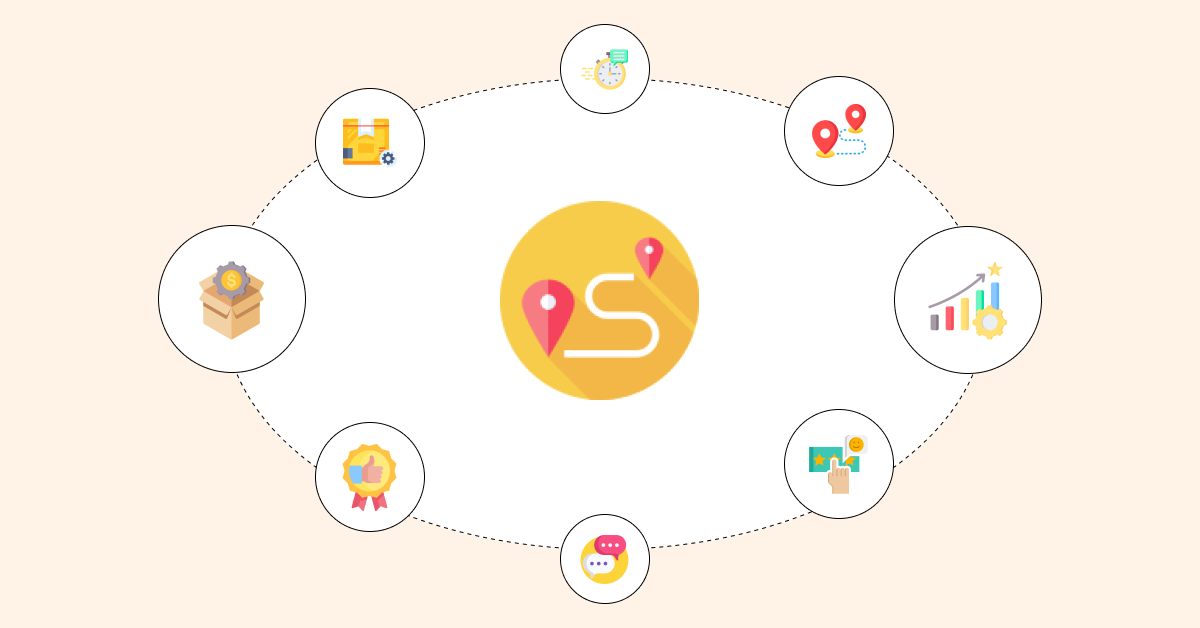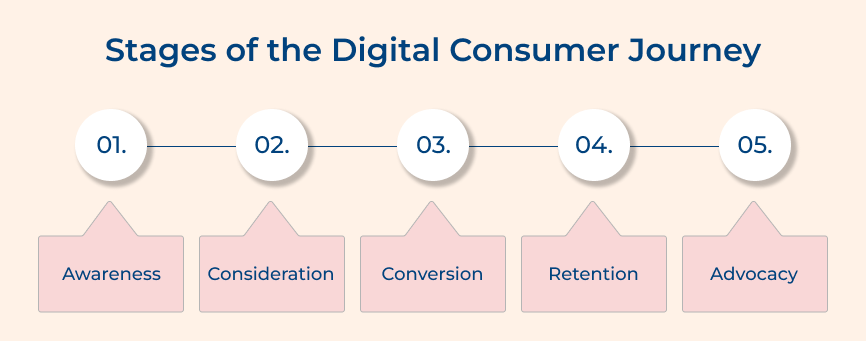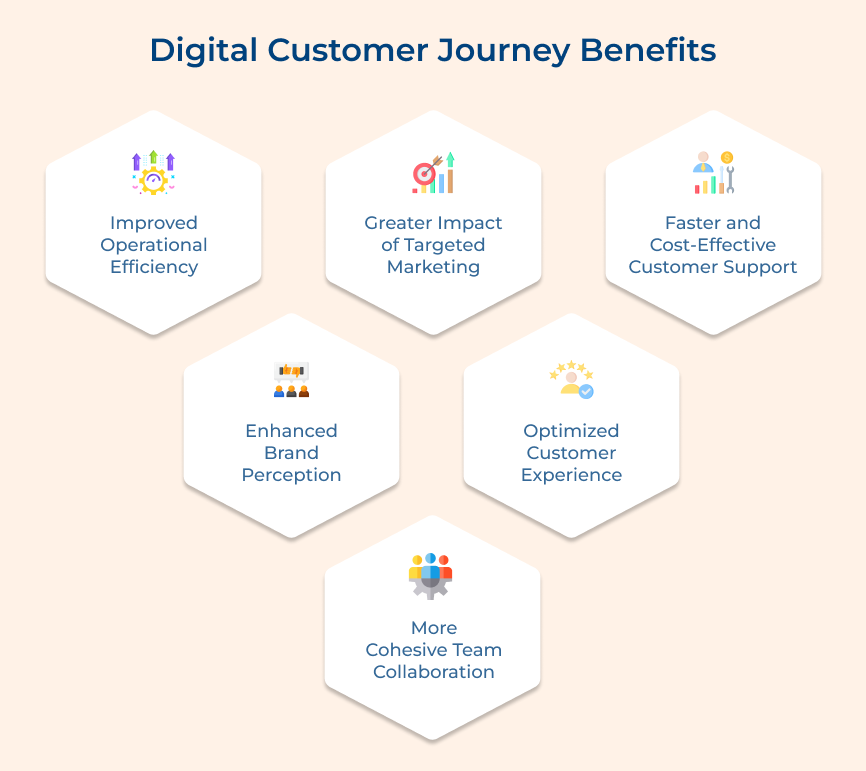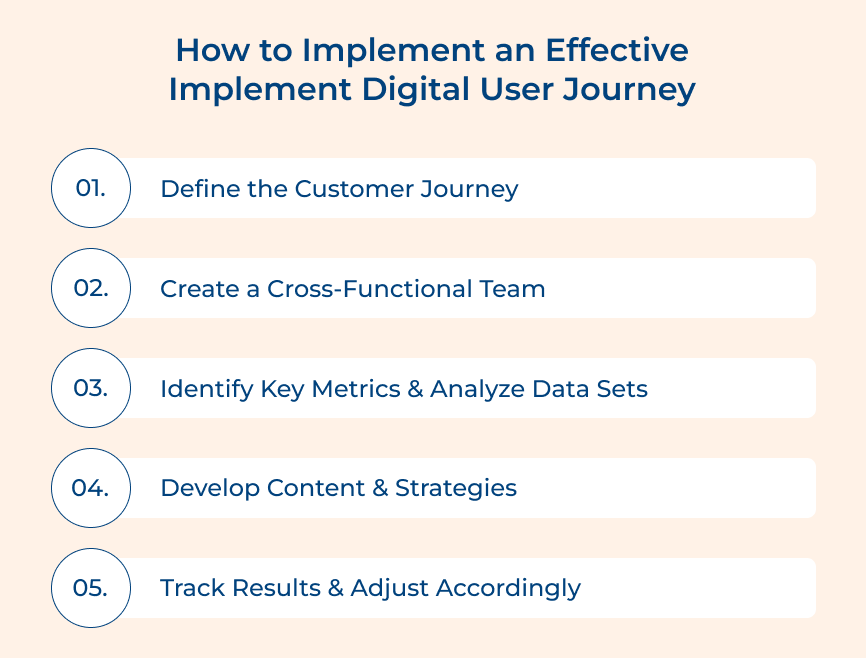1. Define the Customer Journey Maps
The first step toward creating an effective digital user journey is to define it for your business. It involves mapping out the stages of interaction between a customer and your company from initial contact through purchase and post-sale care. A well-defined customer journey should include specific triggers in each stage that will help guide customers along their path through the process.
For example, you may want to create email campaigns for customers who abandon their cart halfway through checkout. Or you may provide incentives for loyalty rewards program members who are at risk of churning. Developing detailed personas can also help to understand how different types of customers interact with the business differently.
Pro tips:
- Identify specific touch points throughout the entire customer experience
- Design personas to understand different types of customers better
- Use triggers in each stage to move customers forward in the process
- Personalize communications at every stage according to individual needs and interests
2. Create a Cross-Functional Team
Creating a cross-functional team composed of representatives from different departments within the organization is essential to effectively implement a digital marketing customer journey. 83% of digitally maturing companies in our survey reported that they use cross-functional teams. The team should include stakeholders from marketing, sales, service, and operations departments who can provide insights on each part of the process.
Having representatives from each area ensures that everyone has input into how the digital customer journey looks from beginning to end instead of just one particular department’s perspective. The collaboration across teams also allows for more creative solutions as team members can draw upon their experiences in other areas to come up with ideas on how to solve them more effectively.
Pro tips:
- Assemble representatives from all relevant departments within your organization
- Encourage an open dialogue between all team members throughout the implementation
- Connect teams across departments so they can draw upon experiences in other areas
3. Identify Key Metrics & Analyze Data Sets
Companies must identify key metrics that they want to measure performance against before launching any campaigns or initiatives associated with it. The metrics should be based on data sets collected over time such as the number of conversions per month or return visits across various stages throughout the customer life cycle.
Analyzing the data sets allows businesses to identify weak spots or trends as they relate to performance. Collecting feedback from customers who have interacted with any part of the process can also allow you to gain valuable insights into the digital user journey. The adjustments can then be made accordingly before launching any large-scale initiatives related to it.
Pro tips:
- Identify key metrics before launching any campaigns associated with it
- Analyze data sets collected over time related to performance
- Collect feedback from customers who interacted with any part of the process
4. Develop Content & Strategies
Developing content for your digital journey is essential for engaging potential new customers while keeping existing ones informed about news-related offerings or promotions. Content should include visual representations such as videos, images, and infographics alongside text-based materials. Content with relevant images gets 94% more views than content without relevant images.
Strategies tailored towards different ensure they receive messages most relevant to where they currently stand. Leveraging automation technologies such as AI-powered chatbots enable businesses to offer personalized conversations. It allows faster response times leading to higher satisfaction rates, especially amongst those seeking immediate answers regarding inquiries related to solutions being offered.
Pro tips:
- Create content tailored towards different audiences depending on the buying cycle
- Leverage automation technologies such as AI-powered chatbots
- Utilize visuals such as videos, images and infographics alongside text-based materials
5. Track Results & Adjust Accordingly
Once you have implemented a digital marketing customer journey it is important to track results regularly, analyze those findings and make the necessary adjustments necessary. Tracking results entails measuring numerous variables including but not limited to engagement levels, average time spent on a page, conversion rates, etc.
How Automation & AI Can Help to Optimize Digital Journeys
Following are the key use cases where automation and artificial intelligence can help optimize the digital consumer journey:
Automate Lead Capture
Lead capture models employ automated data collection systems, such as web forms, chatbots, or interactive voice response (IVR) systems. It enables customers to sign up for marketing information or engage with the brand directly. Automated lead capture is a great way to quickly and effectively capture customer information to generate leads for marketing campaigns.
Personalize Website Content
AI-powered technologies like natural language processing (NLP) and machine learning allow you to deliver website content tailored to each visitor’s interests in real time. Companies can provide customers with more relevant information based on their past searches and behaviors. It makes them feel heard and understood by your brand.
Automated Chatbots for Customer Service
Incorporating a chatbot allows organizations to automate their customer service process within websites, applications, or social media platforms 24/7. It helps businesses provide quick answers to inquiries, consult about products/services and execute orders even when the team may not be available.
Streamline Checkout Processes
Automated checkout processes enable customers to quickly purchase goods without having to leave the website or fill out too many forms for every transaction. Automatic form-filling features like autocomplete ensure customers don’t have to sift through long lists or type out fields they already filled out previously—all with a single click.
Personalized Recommendations
Leveraging machine learning algorithms enables companies to create unique customer profiles that look into factors such as demographics or purchase history for tailored recommendations. The majority of business leaders report an increase in consumer spending by an average of 38% when their experience is personalized.
Targeting Customers Through Contextual Advertising
Contextual advertising allows marketers to give customers an effective personalized message across multiple devices by looking into the user’s recent search activity. They generate more focused advertisements that correspond with what potential buyers are already looking for.
Common Mistakes When Implementing or Optimizing Digital Customer Marketing Journey
Let us analyze the most common mistakes businesses make while implementing or optimizing digital consumer journeys and how to fix them:
Misalignment with Business Objectives
Only 17% of organizations clearly define their digital consumer journey strategy. Those who define it properly usually fail to ensure that the objectives of their organization are properly aligned with the digital customer journey they are implementing. Companies must identify their goals and objectives before beginning the implementation process.
Non-Integrated Platforms
An integrated platform helps streamline processes across all departments, which improves communication between teams and simplifies activities such as marketing campaigns. If your platforms are not integrated, you should consider moving all systems over to one platform that provides multi-channel integration solutions for your entire organization.
Unclear Differentiation Between Channels
Your digital channels should be complementary and distinct from one another, providing unique experiences that cater to different types of audiences on each channel. When users visit multiple platforms such as Twitter or Facebook, they expect different content tailored specifically for them based on their recent interactions or prior engagements on the channels.
Knowledge of Analytics Tools & Monitoring Systems
Due to the lack of proper analytics tools companies are unable to collect the right metrics and insights needed for measuring success during each stage of the customer journey process. Companies can mitigate the issue by using analytics software such as Google Analytics or Adobe Analytics. It allows the user to keep track of user engagement throughout all phases of the customer journey process.
Reduced Investment
Content creation is a critical component when optimizing user experience along the digital customer journey process by helping maintain user loyalty through engaging content across multiple platforms. For this reason, companies must invest in content creators who have a direct understanding of audience needs to develop appropriate strategies.
Not Prioritizing Mobile
Mobile accounts for approximately 50% of web traffic worldwide, making it critically important for businesses investing in digital initiatives. Companies must digital consumer journey strategies centered around mobile optimization if they want to succeed. It includes creating optimized mobile websites as well as integrating features such as mobile payment services into apps.
Reap Benefits & Manage your Digital Customer Journey Effectively
The digital customer marketing journey represents a shift away from traditional one-way marketing tactics towards more personalization-driven approaches across multiple digital touchpoints. It provides a unique interactive experience tailored specifically for each user’s needs.
Personalization efforts combined with predictive analytics automation allow small businesses to increase their revenue through optimized user engagement platforms. They no longer have to worry about getting additional resources necessary for such gains in other forms of marketing.














